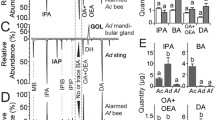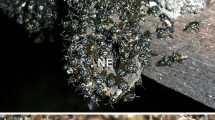Abstract
Foragers of Bombus terrestris are able to alert their nestmates to the presence of food sources. It has been supposed that this happens at least partially through the distribution of a pheromone inside the nest. We substantiate this claim using a behavioral test in which an alerting signal is transmitted from one colony to another by long distance air transport, so excluding all other modalities of information exchange. We then investigated the source of the pheromone and were able to show that a hexane extract from tergites V–VII of bumble bee workers elicits higher activity, like a successful forager does. Extracts from other glands, such as the mandibular, labial, hypopharyngeal, and Dufour's gland as well as extracts from other parts of the cuticle had no effect. This suggests that bumble bees possess a pheromone-producing gland, similar to the Nasanov gland in honey bees. Indeed, an extract from the honey bee Nasanov gland also proved to alert bumblebee workers, suggesting a possible homology of the glands.




Similar content being viewed by others
References
Altenkirch G (1961) Untersuchungen über die Morphologie der abdominalen Hautdrüsen einheimischer Apiden. Z Beitr 7:161–220
Cruz-Landim C (1963) Evaluation of the wax and scent glands in the Apinae. N Y Entomol Soc 21:2–13
Dornhaus A, Chittka L (1999) Evolutionary origins of bee dances. Nature 401:38
Dornhaus A, Chittka L (2001) Food alert in bumblebees (Bombus terrestris): possible mechanisms and evolutionary implications. Behav Ecol Sociobiol 50:570–576
Duffield RM, Wheeler JW, Eickwort GC (1984) Sociochemicals of bees. In: Bell WJ, Cardé RT (eds) Chemical ecology of insects. Chapman and Hall, London
Free JB (1987) Pheromones of social bees. Cornell University Press, Ithaca
Heinrich B (1979) Bumblebee economics. Harvard University Press, Cambridge
Hesselhaus F (1922) Die Hautdrüsen der Apiden und verwandter Formen. Z Jahrb 43:369–463
Hölldobler B, Wilson EO (1990) The ants. Harvard University Press, Cambridge
Jacobs W (1925) Das Duftdrüsenorgan von Apis mellifica und ähnliche Hautdrüsenorgane sozialer und solitärer Apiden. Z Morphol Ökol Tiere 3:1–80
Lindauer M, Kerr WE (1960) Communication between the workers of stingless bees. Bee World 41:29–71
Nieh JC (1998) The food recruitment dance of the stingless bee, Melipona panamica. Behav Ecol Sociobiol 43:133–145
Oeynhausen A, Kirchner W (2001) Vibrational signals of foraging bumblebees (Bombus terrestris) in the nest. IUSSI 2001, Berlin
Renner M (1960) Das Duftorgan der Honigbiene und die physiologische Bedeutung ihres Lockstoffes. Z Vergl Physiol 43:411–468
Snodgrass RE (1956) Anatomy of the honey bee. Comstock, New York
Acknowledgements
We wish to thank the many motivated students who contributed to the experimental results reported in this paper, in particular Daniel Lüftenegger. This project was funded by DFG grants GRK 200, SFB 554 and Ch 147/3-1.
Author information
Authors and Affiliations
Corresponding author
Rights and permissions
About this article
Cite this article
Dornhaus, A., Brockmann, A. & Chittka, L. Bumble bees alert to food with pheromone from tergal gland. J Comp Physiol A 189, 47–51 (2003). https://doi.org/10.1007/s00359-002-0374-y
Received:
Revised:
Accepted:
Published:
Issue Date:
DOI: https://doi.org/10.1007/s00359-002-0374-y




